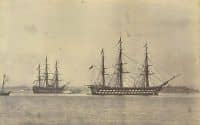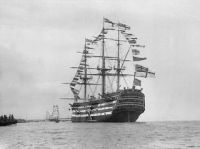Old Naval Ships Images Gallery
This section contains images of Naval Ships from the Age of Sail.
You can open the articles to see a full sized image

This image is of HMS Conway (ex HMS Nile) stranded in 1953.
HMS Conway was a naval training school founded in 1859 usually based on a former wooden ship in the Sloyne, off Rock Ferry on the River Mersey and named after the first ship to fulfil this role. Subsequent ships were renamed accordingly.

This image is of HMS Donegal (right front) and in the background HMS Sans Pareil (centre) and an unknown gunboat (left).
HMS Donegal was a 101-gun screw-driven ship of the line launched at Devonport Dockyard in 1858.

This image is of HMS Dreadnought. It is unclear which of the two ships of line that bore this name during the early years of photography this is.
One was a 98 gun ship launched in 1801 which was at Trafalgar but was taken out of commission in 1812 and became a quarantine and then hospital ship before being broken up in 1857. The other was launched as the 120 gun HMS Caledonia in 1808. She was renamed Dreadnought in 1856 when she was made a hospital ship at Greenwich until 1871, being broken up in 1875.

This image is of HMS Duke of Wellington a 131 gun sail & steam ship of the line launched in 1852.
She was originally to be named HMS Windsor Castle, but as she was launched on the day the Duke of Wellington died this plan was changed. She served as the flagship of the Baltic fleet during the Crimean War, but as her hull strength had been compromised by her conversion to steam during construction she was paid off in 1856.

This is another image of HMS Duke of Wellington, this time in drydock at Keyham, Devonport Dockyard, in 1854. This was 2 years after her launch.

This image is of HMS Foudroyant, an 80 gun ship of the line commissioned in 1798.
in 1799 Thomas Hardy took command of the ship and Lord Nelson hoisted his flag in her. She was then involved in the efforts to return the Neapolitan royal family to Naples. After the Napoleonic wars she served as Plymouth guard ship until about 1862, when she became a gunnery traing vessel. In the 1890's she was sold and in private hands was to become a training ship.

This image is of HMS Foudroyant and Cutty Sark at Falmouth about 1920. This Foudroyant is not the one in the other image, but the former 38-gun frigate HMS Trincomalee, which replaced her after her wreck and was renamed Foudroyant. Cutty Sark is of course the famous Clipper ship.

This image is of HMS Galatea (fore) and HMS Challenger.
HMS Galatea was a 26 gun Jason-class wooden steam screw frigate launched in 1859. She served in the Channel Squadron, Baltic, Mediterranean, North America and West Indies. In 1866 she went on a world cruise, under the command of Prince Alfred, Duke of Edinburgh and in 1882 took the Duke of Edinburgh to the official opening of the new Eddystone Light. She was broken up in 1883.

This image is of HMS Gibraltar and an unknown ship at Devonport in 1867.
Gibraltar was a 101 gun two deck steam ship of the line, the last wooden steam line-of-battleship to commission in the Royal Navy. Commissioned in 1863 she served in the Mediterranean Fleet before becoming a training ship for boys in Belfast in 1871. She was broken up in 1899.

This image is of HMS Howe. She was a 121-gun screw 3 deck ship of the line (one of only 2 designed from the start for screw propulsion), but was never completed for sea service as ironclad battleships were making unarmoured two and three deckers obsolete at this time and she only received 12 guns.

This is another image of HMS Howe whilst she was serving as the training ship HMS Impregnable.

This image is of HMS Rodney, a two deck 90 gun ship of the line, launched in 1833 at Pembroke Dockyard. She saw active service in the Mediterranean Sea and also in the Black Sea during the Crimean War.

This image is of HMS Royal Adelaide at Devonport in 1880. She was a 104 gun ship of the line, launchedy 1828 at Plymouth. Royal Adelaide was converted to serve as a depot ship in 1860, and was eventually sold in 1905.

This image is of HMS Trincomalee in her current role of museum ship in Hartlepool. Launched at Bombay, India,in 1817, just after the end of the Napoleonic war, she is a Leda class frigate built in teak. After being fitted out in Portsmouth, UK, Trincomalee was placed in reserve until 1845.

This image is of HMS Victory at Spithead in 1911. Nelson's flagship at Trafalgar needs no description from me, but this series of images shows her at a time when she was still afloat.

This image is of HMS Victory in 1900 (tinted). Nelson's flagship at Trafalgar needs no description from me, but this series of images shows her at a time when she was still afloat.

This image is of HMS Victory in 1884. Nelson's flagship at Trafalgar needs no description from me, but this series of images shows her at a time when she was still afloat.

This image is of HMS Victory. Nelson's flagship at Trafalgar needs no description from me, but this series of images shows her at a time when she was still afloat.

This image is of HMS Victory. Nelson's flagship at Trafalgar needs no description from me, but this series of images shows her at a time when she was still afloat.

This image is of HMS Warrior a 40-gun steam-powered armoured frigate launched in 1860. She was the first armour-plated, iron-hulled warship, built in response to the launch in 1859 of the wooden-hulled Gloire by France, the first ocean-going ironclad warship. She spent her active career with the Channel Squadron before becoming obsolete in 1873 when the mastless and more capable HMS Devastation was commissioned. Warrior was placed in reserve in 1875, and was decommissioned in 1883.

This image is of USS Constitution in 1997. Also known as "Old Ironsides", she is a 3 masted wooden-hulled heavy frigate launched in 1797. She is the world's oldest commissioned naval warship still afloat.


